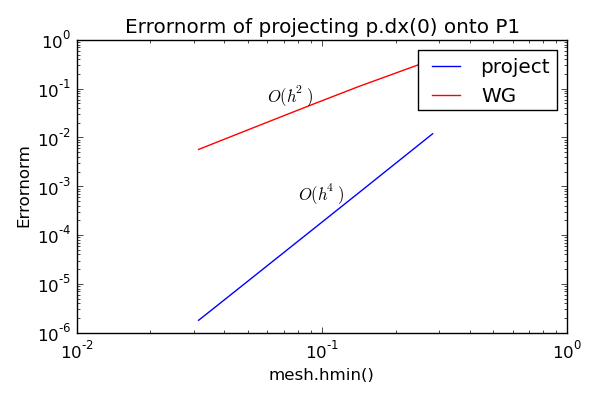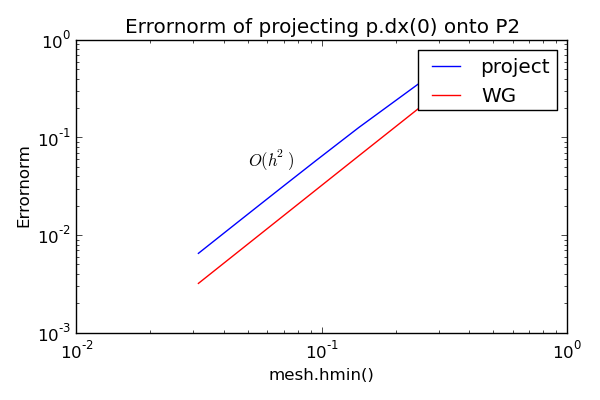-
Notifications
You must be signed in to change notification settings - Fork 36
Weighted gradient matrix
Mikael Mortensen edited this page Aug 15, 2017
·
34 revisions
The module WeightedGradient.py contains a function for computing a weighted gradient matrix. Using the weighted gradient matrix, the gradient of a P1 Function may be computed very fast using merely a single matrix vector product. The gradient can be computed on a continuous Lagrange space of any degree.
from dolfin import *
from fenicstools.WeightedGradient import weighted_gradient_matrix
mesh = UnitSquareMesh(10, 10)
V = FunctionSpace(mesh, "CG", 1)
# Set an exact solution
p = interpolate(Expression("sin(x[0])*cos(x[1])"), V)
dpdxe = interpolate(Expression("cos(x[0])*cos(x[1])"), V)
dpdye = interpolate(Expression("-sin(x[0])*sin(x[1])"), V)
# Compute gradient of p on V
dP = weighted_gradient_matrix(mesh, (0, 1), 1)
dpdx = Function(V)
dpdy = Function(V)
dpdx.vector()[:] = dP[0]*p.vector()
dpdy.vector()[:] = dP[1]*p.vector()
# Compute gradient using regular projection
dpdxp = project(p.dx(0), V)
dpdyp = project(p.dx(1), V)The accuracy of the weighted gradient matrix is investigated using the following script that is periodic to eliminate boundary effects.
from dolfin import *
from pylab import loglog, show, legend, title, xlabel, text, ylabel, figure
from fenicstools.WeightedGradient import weighted_gradient_matrix
class PeriodicDomain(SubDomain):
def inside(self, x, on_boundary):
return bool((near(x[0], 0) or near(x[1], 0)) and
(not ((near(x[0], 0) and near(x[1], 2)) or
(near(x[0], 2) and near(x[1], 0)))) and on_boundary)
def map(self, x, y):
if near(x[0], 2) and near(x[1], 2):
y[0] = x[0] - 2.0
y[1] = x[1] - 2.0
elif near(x[0], 2):
y[0] = x[0] - 2.0
y[1] = x[1]
else:
y[0] = x[0]
y[1] = x[1] - 2.0
constrained_domain = PeriodicDomain()
for vel_deg in (1, 2): # Loop over two degrees in FunctionSpace interpolated to
err_reg = []
err_wg = []
hmin = []
for N in range(10, 100, 10): # Loop over different mesh sizes
mesh = RectangleMesh(0, 0, 2, 2, N, N)
Q = FunctionSpace(mesh, "CG", 1, constrained_domain=constrained_domain)
V = FunctionSpace(mesh, "CG", vel_deg, constrained_domain=constrained_domain)
u = TrialFunction(V)
v = TestFunction(V)
# Exact solution
p = interpolate(Expression("sin(pi*x[0])*cos(pi*x[1])"), Q)
dp_exact = interpolate(Expression("pi*cos(pi*x[0])*cos(pi*x[1])"), V)
dp_exact.update()
# Compute regular projection
dp_regular = project(p.dx(0), V)
# Compute solution using weighted gradient matrix
dP = weighted_gradient_matrix(mesh, 0, vel_deg, constrained_domain=constrained_domain)
dp_wg = Function(V)
dp_wg.vector()[:] = dP * p.vector()
# Compute error
err_reg.append(errornorm(dp_regular, dp_exact, degree_rise=0))
err_wg.append(errornorm(dp_wg, dp_exact, degree_rise=0))
hmin.append(mesh.hmin())
# Plot the errornorms
figure()
loglog(hmin, err_reg, 'b')
loglog(hmin, err_wg, 'r')
legend(("project", "WG"))
title("Errornorm of projecting p.dx(0) onto P{}".format(vel_deg))
ylabel("Errornorm")
xlabel("mesh.hmin()")
if vel_deg == 1:
text(0.08, 5e-4, "$O(h^4)$")
text(0.06, 0.05, "$O(h^2)$")
else:
text(0.06, 0.05, "$O(h^2)$")
show()The error plots are shown below. Due to superconvergence the regular project function reaches a whopping 4th order accuracy for this problem on P1 elements because of the regular size and alignment of the mesh. A skewed mesh or "crossed" type reduces the order to 2 also for the regular project function.

